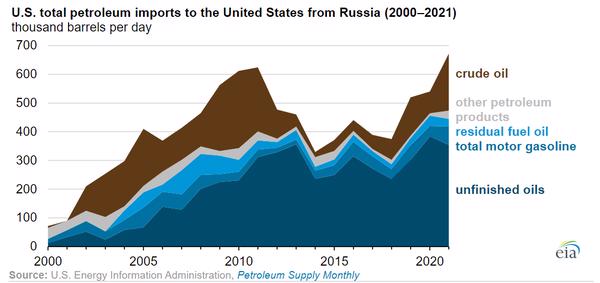US refineries need to find replacement to Russian feedstock - EIA
With a US embargo on Russian oil is in place, it is clear that US refiners have relied just as much on imports of Russian unfinished M-100 oil and residual fuel oil as on imports of Russian crude oil as feedstocks, the US Energy Information Administration's (EIA) Kevin Hack says.

CHART: Total US crude oil imports outweigh oil products imports by volume, but the Russian share is smaller. EIA
Crude oil made up around 29% of the US total petroleum imports from Russia last year, with the rest being split between unfinished oils, gasoline, residual fuel oil and other petroleum products.
Unfinished oils made up more than half of imports with 672,000 b/d in 2021. Much of these unfinished oils were Mazut-100 (M-100), which can feed refinery units as alternatives to heavy-sour crude grades, Kevin Hack says.

CHART: Two decades of US petroleum imports from Russia. EIA
US residual fuel oil imports from Russia were around 27,000 b/d last year, making up roughly 15% of total US fuel oil imports.
More than half of these Russian fuel oil imports had sulphur contents above 1%, meaning the fuel would have to be desulpherised or blended to meet specifications for VLSFO, the main bunker fuel oil grade in US ports.
A significant portion of the fuel oil would also have gone to refineries as feedstock, just like M-100 does, Hack argues.
Complex US refineries can take fuel oil to feed secondary units, such as cokers, and 'upgrade' to lighter and typically higher-value petroleum products like gases, naphtha and gasoil, with petroleum coke as a by-product.
On 8 March, US President Joe Biden announced an executive order to ban imports of Russian crude oil, petroleum products, coal and natural gas in response to Russia's invasion of Ukraine.






